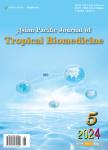Prevalence and antimicrobial resistance of non-typhoid Solmonella in military personnel,1988-2013
Prevalence and antimicrobial resistance of non-typhoidSalmonella in military personnel, 1988-2013作者机构:Department of Enteric DiseasesArmed Forces Research Institute of Medical SciencesBangkokThailand Armed Forces Research Institute of Medical Sciencescurrent affiliation of the Henry M.Jackson FoundationBethesdaMDUSA
出 版 物:《Asian Pacific Journal of Tropical Biomedicine》 (亚太热带生物医学杂志(英文版))
年 卷 期:2018年第8卷第6期
页 面:387-392页
核心收录:
学科分类:1002[医学-临床医学] 100201[医学-内科学(含:心血管病、血液病、呼吸系病、消化系病、内分泌与代谢病、肾病、风湿病、传染病)] 10[医学]
基 金:supported by the Armed Forces Health Surveillance Branch and its Global Emerging Infectious Disease Surveillance and Response Section Funding of this project was partially provided by the U.S.Army Medical and Material Command
主 题:Non-typhoid Salmonella Antimicrobial resistance Azithromycin Deployed military Public health Thailand
摘 要:Objective:To describe the spanning 25 years data for the occurrence, magnitude, and trends regarding antimicrobial resistance of non-typhoidalSalmonella (NTS) isolated from non-immune travelers to Thailand participating in joint military ***:A total of 355 NTS isolates, obtained from 2052 fecal samples from US soldiers deployed for military maneuvers in Thailand during 1988-2013, were examined for NTS serogroup/serotypes and tested for antimicrobial susceptibility by disk diffusion to these 10 antibiotics:ampicillin, azithromycin (AZM), ciprofloxacin, colistin, gentamicin, kanamycin, nalidixic acid, streptomycin (STR), tetracycline (TET), and trimethoprim/sulfamethoxazole. Identified AZM-resistant NTS isolates were further evaluated for their minimal inhibitory concentration by the E-test ***:NTS infections accounted for 17.3% (355/2052), including 11 serogroups and 50 different serotypes. The most prevalent serogroup wasSalmonella group C2-C3 (35.8%, 127/355) followed by groups B (21.1%, 75/355) and C1 (18.6%, 66/355). Identified serotypes includedSalmonellahadar (n=60),Salmonellarissen (n=45), andSalmonella blockley (n=34). Among the predominate serogroups, antimicrobial resistance was consistently high against TET (76.9%, 273/355) followed by STR (40.8%, 145/355). OneSalmonella senftenberg isolate demonstrated decreased ciprofloxacin susceptibility. Most isolates (94.6%) were resistant to one or more antimicrobials, and the most common multidrug resistance was TET-STR-nalidixic acid (11.5%, 41/355).Conclusions:The prevalence of NTS serotypes and the growing magnitude of antibiotic resistant bacteria isolated from deployed US military in Thailand are documented from 1988-2013. This study demonstrates the antibiotic resistance profiles, highlighting the effectiveness of AZM that is a first-line treatment for travelers to Southeast Asia. AZM-resistant NTS isolates are periodically observed over a 25-year period. Hence, the ongoing surveilla



